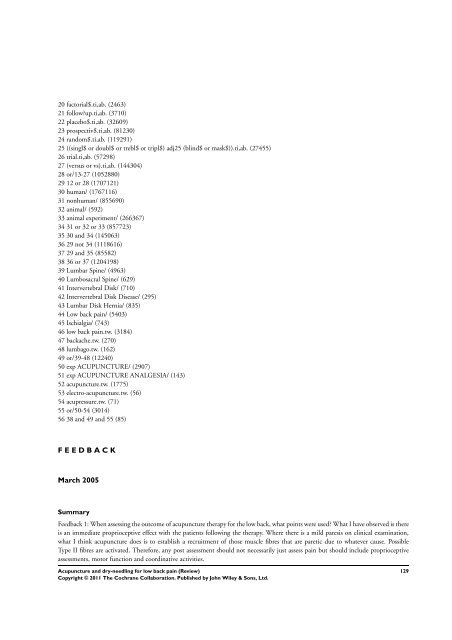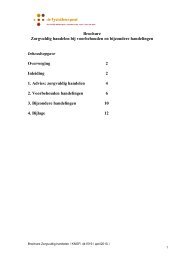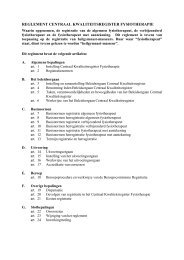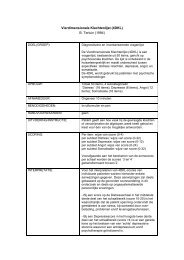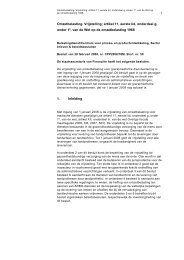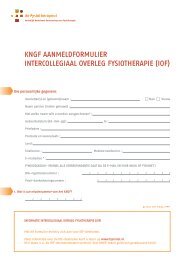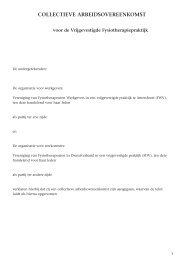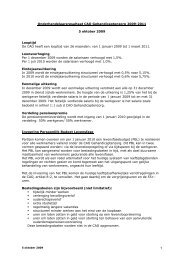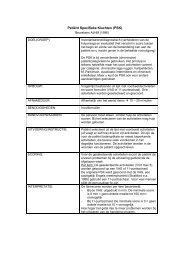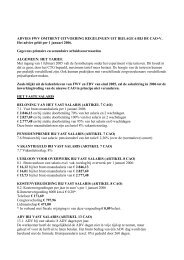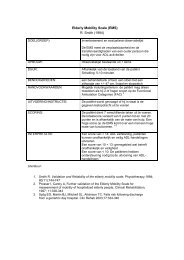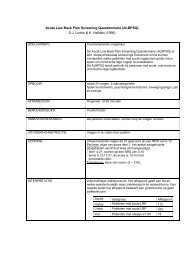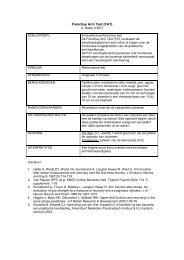Acupuncture and dry-needling for low back pain (Review)
Acupuncture and dry-needling for low back pain (Review)
Acupuncture and dry-needling for low back pain (Review)
You also want an ePaper? Increase the reach of your titles
YUMPU automatically turns print PDFs into web optimized ePapers that Google loves.
20 factorial$.ti,ab. (2463)<br />
21 fol<strong>low</strong>?up.ti,ab. (3710)<br />
22 placebo$.ti,ab. (32609)<br />
23 prospectiv$.ti,ab. (81230)<br />
24 r<strong>and</strong>om$.ti,ab. (119291)<br />
25 ((singl$ or doubl$ or trebl$ or tripl$) adj25 (blind$ or mask$)).ti,ab. (27455)<br />
26 trial.ti,ab. (57298)<br />
27 (versus or vs).ti,ab. (144304)<br />
28 or/13-27 (1052880)<br />
29 12 or 28 (1707121)<br />
30 human/ (1767116)<br />
31 nonhuman/ (855690)<br />
32 animal/ (592)<br />
33 animal experiment/ (266367)<br />
34 31 or 32 or 33 (857723)<br />
35 30 <strong>and</strong> 34 (145063)<br />
36 29 not 34 (1118616)<br />
37 29 <strong>and</strong> 35 (85582)<br />
38 36 or 37 (1204198)<br />
39 Lumbar Spine/ (4963)<br />
40 Lumbosacral Spine/ (629)<br />
41 Intervertebral Disk/ (710)<br />
42 Intervertebral Disk Disease/ (295)<br />
43 Lumbar Disk Hernia/ (835)<br />
44 Low <strong>back</strong> <strong>pain</strong>/ (5403)<br />
45 Ischialgia/ (743)<br />
46 <strong>low</strong> <strong>back</strong> <strong>pain</strong>.tw. (3184)<br />
47 <strong>back</strong>ache.tw. (270)<br />
48 lumbago.tw. (162)<br />
49 or/39-48 (12240)<br />
50 exp ACUPUNCTURE/ (2907)<br />
51 exp ACUPUNCTURE ANALGESIA/ (143)<br />
52 acupuncture.tw. (1775)<br />
53 electro-acupuncture.tw. (56)<br />
54 acupressure.tw. (71)<br />
55 or/50-54 (3014)<br />
56 38 <strong>and</strong> 49 <strong>and</strong> 55 (85)<br />
F E E D B A C K<br />
March 2005<br />
Summary<br />
Feed<strong>back</strong> 1: When assessing the outcome of acupuncture therapy <strong>for</strong> the <strong>low</strong> <strong>back</strong>, what points were used? What I have observed is there<br />
is an immediate proprioceptive effect with the patients fol<strong>low</strong>ing the therapy. Where there is a mild paresis on clinical examination,<br />
what I think acupuncture does is to establish a recruitment of those muscle fibres that are paretic due to whatever cause. Possible<br />
Type II fibres are activated. There<strong>for</strong>e, any post assessment should not necessarily just assess <strong>pain</strong> but should include proprioceptive<br />
assessments, motor function <strong>and</strong> coordinative activities.<br />
<strong>Acupuncture</strong> <strong>and</strong> <strong>dry</strong>-<strong>needling</strong> <strong>for</strong> <strong>low</strong> <strong>back</strong> <strong>pain</strong> (<strong>Review</strong>)<br />
Copyright © 2011 The Cochrane Collaboration. Published by John Wiley & Sons, Ltd.<br />
129


